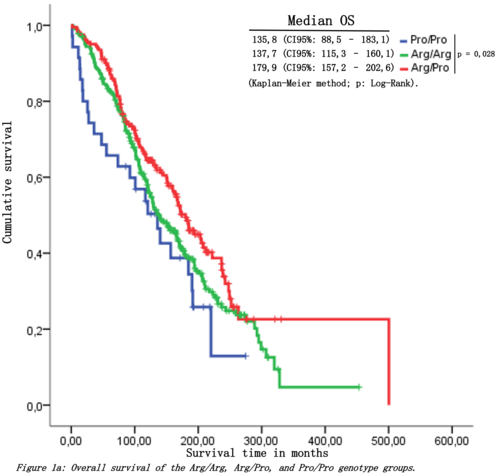
Contributions
Abstract: EP621
Type: E-Poster Presentation
Session title: Chronic lymphocytic leukemia and related disorders - Biology & Translational Research
Background
Predictors of a transformation of chronic lymphocytic leukemia (CLL) into Richter syndrome (RS) have not been yet established, although biomarkers that have been reported as associated with risk of DLBCL-type RS development include the mutational status of NOTCH1, TP53 abnormalities, and the use of subset 8 immunoglobulin genes (IGHV4-39). On the other hand, second malignancies are frequent complications in patients with CLL, and immune defects associated with this disease have been suggested as the main cause. The possibility was raised that some germline TP53 polymorphisms in healthy populations may also affect p53 function. Because of this, much research has been done on the ability of SNPs to cause alterations in p53 function in many types of cancer. One of the most studied polymorphisms is codon 72 (R72P), due to its potential effect on the risk of cancer.
Aims
In this study, we will analyze the relationship of the genotypes of the TP53 codon 72 polymorphisms in a large cohort of patients with CLL, to demonstrate the association of codon 72 with the evolution of the disease.
Methods
558 patients diagnosed with CLL were included from a group of hospitals for the study of chronic lymphoproliferative disorders, with clinical data at diagnosis, including immunophenotype, FISH, IgHV, and karyotype studies. RT-PCR and Sanger sequencing techniques analyzed the codon 72 Arg/Arg, Arg/Pro, and Pro/Pro genotypes of TP53.
Results
The Pro/Pro genotype was significantly associated with Binet stage B and C CLL, Richter transformation, and a shorter time to the first treatment. Besides, Pro/Pro and Arg/Arg genotypes was associated with a risk of have secondary neoplasms (p=0,016). Follow-up assessments showed secondary neoplasms in 19.7% (n=110) of the patients, with the tumors appearing in the bladder, skin, and colon (14.5% each), prostate (13.6%), and the lung (12.7%). During the study period, 335 patients died. Analyses of overall survival demonstrated that patients with the Pro/Pro genotype lived significantly less than those with the other genotypes (p=0,028) (Figure 1). In the subgroup of patients with RS, no significant differences were found, although a trend of lower survival was observed in patients with the Pro / Pro genotype, and that in turn, the patients with RS with Pro/Pro genotype have much shorter survival than those without RS. Finally, in the multivariate analysis, the Pro/Pro homozygous genotype at TP53 codon 72 was identified as an independent variable associated with a 1,728-fold increased risk of death (95% CI: 1.062-2.810; P = 0,028) in comparison with the Arg/Pro heterozygous genotype.

Conclusion
Thus, we conclude that the Pro/Pro genotype of TP53 codon 72 has a potential role in the progression and mortality of CLL patients, and maybe it could be related to RS. In contrast, the Arg/Pro genotype was associated with a lower risk of secondary neoplasms than the homozygous genotypes.
Keyword(s): P53
Abstract: EP621
Type: E-Poster Presentation
Session title: Chronic lymphocytic leukemia and related disorders - Biology & Translational Research
Background
Predictors of a transformation of chronic lymphocytic leukemia (CLL) into Richter syndrome (RS) have not been yet established, although biomarkers that have been reported as associated with risk of DLBCL-type RS development include the mutational status of NOTCH1, TP53 abnormalities, and the use of subset 8 immunoglobulin genes (IGHV4-39). On the other hand, second malignancies are frequent complications in patients with CLL, and immune defects associated with this disease have been suggested as the main cause. The possibility was raised that some germline TP53 polymorphisms in healthy populations may also affect p53 function. Because of this, much research has been done on the ability of SNPs to cause alterations in p53 function in many types of cancer. One of the most studied polymorphisms is codon 72 (R72P), due to its potential effect on the risk of cancer.
Aims
In this study, we will analyze the relationship of the genotypes of the TP53 codon 72 polymorphisms in a large cohort of patients with CLL, to demonstrate the association of codon 72 with the evolution of the disease.
Methods
558 patients diagnosed with CLL were included from a group of hospitals for the study of chronic lymphoproliferative disorders, with clinical data at diagnosis, including immunophenotype, FISH, IgHV, and karyotype studies. RT-PCR and Sanger sequencing techniques analyzed the codon 72 Arg/Arg, Arg/Pro, and Pro/Pro genotypes of TP53.
Results
The Pro/Pro genotype was significantly associated with Binet stage B and C CLL, Richter transformation, and a shorter time to the first treatment. Besides, Pro/Pro and Arg/Arg genotypes was associated with a risk of have secondary neoplasms (p=0,016). Follow-up assessments showed secondary neoplasms in 19.7% (n=110) of the patients, with the tumors appearing in the bladder, skin, and colon (14.5% each), prostate (13.6%), and the lung (12.7%). During the study period, 335 patients died. Analyses of overall survival demonstrated that patients with the Pro/Pro genotype lived significantly less than those with the other genotypes (p=0,028) (Figure 1). In the subgroup of patients with RS, no significant differences were found, although a trend of lower survival was observed in patients with the Pro / Pro genotype, and that in turn, the patients with RS with Pro/Pro genotype have much shorter survival than those without RS. Finally, in the multivariate analysis, the Pro/Pro homozygous genotype at TP53 codon 72 was identified as an independent variable associated with a 1,728-fold increased risk of death (95% CI: 1.062-2.810; P = 0,028) in comparison with the Arg/Pro heterozygous genotype.

Conclusion
Thus, we conclude that the Pro/Pro genotype of TP53 codon 72 has a potential role in the progression and mortality of CLL patients, and maybe it could be related to RS. In contrast, the Arg/Pro genotype was associated with a lower risk of secondary neoplasms than the homozygous genotypes.
Keyword(s): P53


